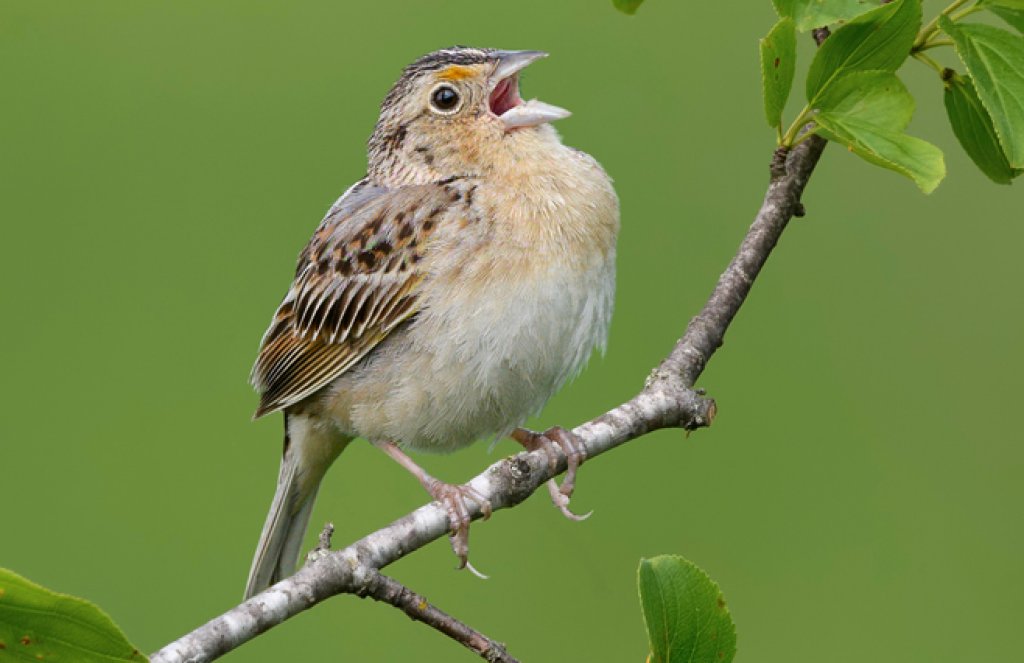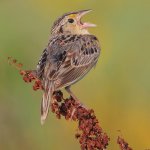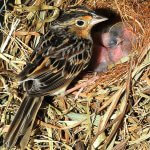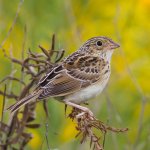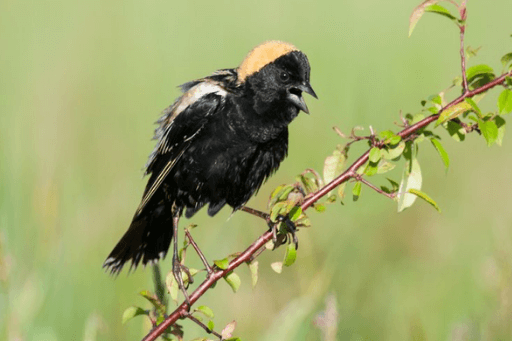About the Grasshopper Sparrow
More often heard than seen, the Grasshopper Sparrow is named for the insect-like quality of its songs. Like its cousins the Henslow's and Baird's Sparrows, the Grasshopper Sparrow appears big-headed and large-billed when compared to more familiar species like the Savannah Sparrow.
Other definitive field marks that help clinch a Grasshopper Sparrow identification: a light-colored, unstreaked breast and touches of yellow at the bend of wing and in front of the eye. Males and females look alike, but a male Grasshopper Sparrow is more likely to be seen during the breeding season, when he sits atop a fence post or other elevated perch to belt out his buzzy song.
It's easy to miss hearing this bird's song, unless you know what to listen for. And there's more to it than just the "buzz."
Buzzing and Trilling
The Grasshopper Sparrow is one of the few sparrow species in which the male sings two different songs. His primary song, used to establish and defend territory and advertise his presence, consists of one to four quiet introductory notes followed by a long, high-pitched trill — tup zeeee! Unpaired males sing this buzzy song as well.
Males also sing an alternate “warble” song during the breeding season to establish and maintain pair bonds. This longer vocalization, sometimes immediately following a primary song, is a rambling series of tuneful, rather squeaky notes, sung from a fixed perch or in flight.
In addition to the male's two songs, male and female Grasshopper Sparrows have different trilled vocalizations, sung during the breeding season to maintain pair bonds and keep in contact, and while approaching the nest. These quieter songs are often difficult for a human observer to hear.
Songs and Sounds
Both male and female Grasshopper Sparrows sing. Listen to a variety of their sounds here!
Male primary song:
Primary song, followed by alternate song:
Insect-like call note:
Breeding and Feeding
Stealth Nester
Shortly after arriving on breeding grounds, male Grasshopper Sparrows sing and perform flight displays to establish territory. Females arrive three to five days later, and the birds quickly form pair bonds. After mating, female Grasshopper Sparrows build well-hidden, cup-shaped grass nests on the ground. They tend to hide the location of their nests, seldom flying directly to them. Instead, they land a short distance away and slip through the grasses to the nest entrance.
Similarly, when leaving, parent birds often run from the nest, taking flight a distance away to avoid signaling the nest's location. Like the Northern Bobwhite, Piping Plover, and other ground-nesting birds, adults will perform broken-wing displays to draw approaching predators away from nests or fledglings.
The female incubates her clutch of three to six eggs for up to 13 days. She sometimes has “helpers” — young from previous broods — to assist with feeding and brooding nestlings. Grasshopper Sparrows may produce a second or even a third brood in the same season, though the first clutch tends to be the largest. Females can build a new nest while feeding larger young in an active nest.
If you're lucky enough to own a large area of grassland where Grasshopper Sparrows nest, you can help these birds. Avoid mowing from late April through July to let the birds produce up to three successful nests, about one a month. (The same recommendation applies to roadsides in agricultural settings.)
Grasshopper Grabber
This species feeds mainly on the ground, preferring open grasslands with patches of bare ground for foraging. During the breeding season, the Grasshopper Sparrow feeds on grasshoppers, along with other insects, spiders, earthworms, and snails.
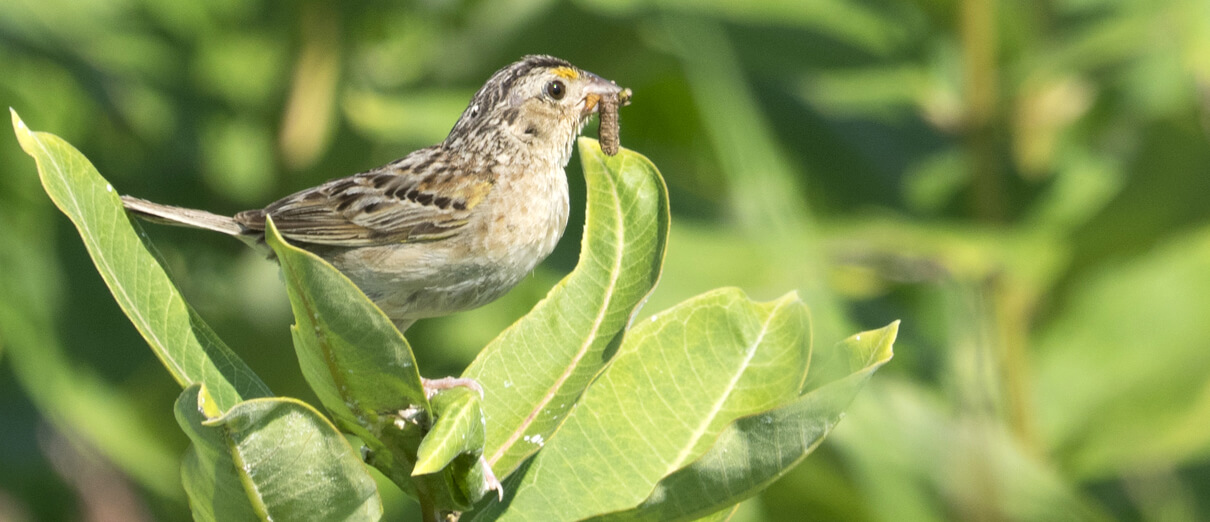
Some food items, like some grasshoppers, can be large prey for a small bird, but the sparrow has a technique to make eating them easier: The bird immobilizes its grasshopper prey, pinching the insect behind the head, then it shakes off the legs before eating it or feeding it to the young.
In fall and winter, these sparrows mainly eat grass seeds and waste grain.
Region and Range
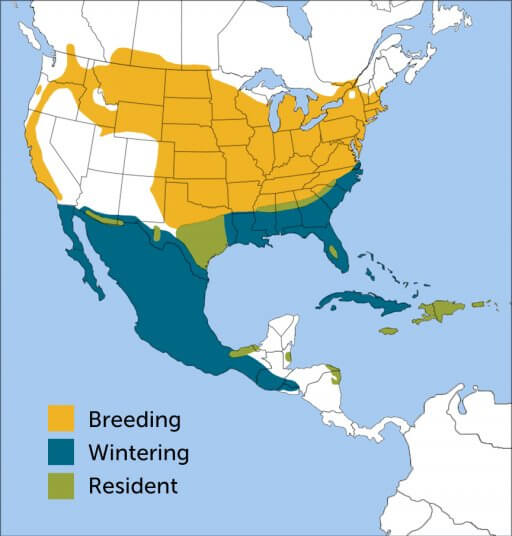
During the breeding season, Grasshopper Sparrows prefer expansive areas of grassy habitat with very few trees. This species breeds across much of the U.S., but is absent as a nester in most of the arid West and Pacific Northwest, as well as large portions of the Southeast (although it nests across much of Texas). In addition, this bird breeds in some parts of southern Canada, as well as in a few spots in Mexico, some Central American countries, and even in one tiny region in Colombia. In the Caribbean, the Grasshopper Sparrow is a scarce breeder on the islands of Hispaniola, Puerto Rico, and Jamaica.
Most populations are migratory, wintering in the southern United States, Mexico, and western Central America. Wintering birds are also found in the Bahamas and Cuba.
Twelve subspecies of Grasshopper Sparrow are recognized. Around 200 individuals of the Florida subspecies (Ammodramus savannarum floridanus) remain in the dry prairie ecosystems of south-central Florida. This subspecies is listed as Endangered by the U.S. Fish and Wildlife Service under the Endangered Species Act (ESA); efforts are underway to help this population recover.
Conservation
Sparrow's Steep Decline
Habitat loss and degradation remain the greatest threats to the Grasshopper Sparrow and other grassland-dependent species such as the Long-billed Curlew and Bobolink. Increased use of pesticides, brood parasitism by Brown-headed Cowbirds, and loss of wintering habitat have also contributed to population declines.

Help support ABC's conservation mission!
Partners in Flight classifies the Grasshopper Sparrow as a “Common Bird in Steep Decline.” This species has lost 68 percent of its population since 1970, mainly due to loss and fragmentation of grassland habitats. In addition to ESA protection for the Florida subspecies, the entire population has been designated a focal species for conservation by the U.S. Fish and Wildlife Service, and an Assessment and Conservation Plan has been developed.
The Grasshopper Sparrow is found in many ABC BirdScapes — landscape-scale areas where partners work to combine smart land use with effective bird conservation, providing habitat to help sustain or recover targeted migratory bird species or populations.
ABC is also advocating for measures to be included in the 2023 Farm Bill that have the best chance of keeping U.S. grassland species such as the Grasshopper Sparrow from disappearing. Recommendations included in ABC's “Bird Saver" platform would help the Farm Bill channel funds designated for conservation to the programs that would make the biggest difference for grasslands and their birds.
Get Involved
Policies enacted by the U.S. Congress and federal agencies, such as the U.S. Fish and Wildlife Service, have a huge impact on migratory birds. You can help shape these rules for the better by telling lawmakers to prioritize birds, bird habitat, and bird-friendly measures. To get started, visit ABC's Action Center.
Living a bird-friendly life can have an immediate impact on migratory birds in the United States. Doing so can be as easy as adding native plants to your garden, avoiding pesticides, and keeping cats indoors. To learn more, visit our Bird-Friendly Life page.
American Bird Conservancy and our Migratory Bird Joint Venture partners have improved conservation management on more than 8.5 million acres of U.S. bird habitat — an area larger than the state of Maryland — over the last ten years. That's not all: With the help of international partners, we've established a network of more than 100 areas of priority bird habitat across the Americas, helping to ensure that birds' needs are met during all stages of their lifecycles. These are monumental undertakings, requiring the support of many, and you can help by making a gift today.





































